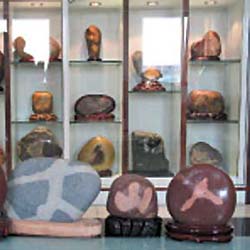
China has a tradition of collecting and appreciating exotic stones and there are many beautiful myths and legends behind some of them. For example, Nuwa, a goddess-creator of the Chinese nation, patches the hole in the sky with colorful stone blocks. Jingwei, a mythical bird said to be the reincarnation of the drowned daughter of Emperor Yan, tries to fill up the sea with pebbles. The literary classic, A Dream of Red Mansions, is said to have been written on a giant stone, hence its alternative title, The Tale of the Stone.
While East and West place different values on the aesthetics of stones, due to the ancient Chinese philosophy of "togetherness of man and nature," collectors in this country focus on cultural connotations and pay more attention to the natural shapes and patterns of the stones.
In the past few decades, with the improvement of people's material life, their interests have widened. Collectors now turn their eyes to stones, which are comparatively easy to find. It is in the shadow of this phenomenon that the Beijing Viewing Stone Museum was set up.
Main attractions: Situated in Beijing's Daxing District, the museum is China's most important base for displaying, researching and marketing viewing stones. With an area of more than 20,000 square meters, it has collected more than 100,000 stones of around 1,000 types including fossil, crystalline mineral, crystal, bloodstone and marble.
Every year the museum co-sponsors several national viewing stone exhibitions to attract collectors and fans throughout the country. This year, from March 25 to April 3, it will organize the Second National Viewing Stone Exhibition. Various seminars will be held then to discuss the "stone culture" and enhance cultural exchange between Chinese and foreign stone collectors.
Eye-catchers: Of all the stones collected in the museum, two are rarely seen: one is "Yin-Yang Stone" and the other is the "Master Painter Stone." Both are naturally presented without any artificial polishing.
The Yin-Yang Stone is a rare stone on which is a natural pattern of the black and white fish, symbolizing Yin and Yang. In ancient Chinese philosophy, Yin and Yang refer to two opposing principles existing in substances, people, and all things under the heaven.
The Master Painter Stone consists of four separate stones, each with a Chinese character. Putting four characters together to form the name of a master painter: Zhu Da (1626-1705), who was a monk painter of the Qing Dynasty. As an outstanding landscape and flower-and-bird painter, Zhu's works had far-reaching repercussions on the artists of the following generations.
Add: Qi Shi Cheng (), Xinjian Science and Technology Region, Daxing District;
Opening hours: 9:00 AM - 5:00 PM, daily;
Traffic: Drive west along the South Fifth Ring Road and enter the auxiliary lane at the Tuanhe Exit. Then turn left through East Zhiyuan overpass and go south for four-kilometers;
Tel: 86-10-81284001.
(China Daily March 23, 2006)
|

